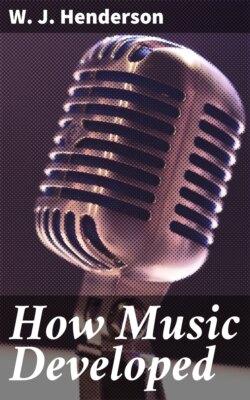Читать книгу How Music Developed - W. J. Henderson - Страница 8
На сайте Литреса книга снята с продажи.
The Golden Age of Church Counterpoint
ОглавлениеTable of Contents
The great Netherlands school—Okeghem and the mechanics of music—Riddles in tone—The advent of pure beauty—Work of Josquin des Prés—Attempts at expression by Willaert and others—Secular music—Orlando Lasso and his beautiful works.
AT the period of musical history which we have now reached, the Dutch, as I have had occasion to say in another work, "led the world in painting, in liberal arts, and in commercial enterprise. Their skill in mechanics was unequalled, and we naturally expect to see their musicians further the development of musical technic." The Dutch musicians at first revelled in the exercise of mechanical ingenuity in the construction of intricate contrapuntal music. In the first period of their great school they acquired by such exercise so great a mastery of the materials of their art that in the second period they began to make serious attempts at writing beautiful music for beauty's sake. In the third period the possibilities of writing something different from church music began to be developed, and we find the Dutch masters attempting the description in tones of external phenomena by the process called tone-painting. This period also saw secular music taken into the fold of art, and began the production of madrigals and other secular songs. In the fourth period the dry old science of counterpoint was so completely conquered that the composers of the time were able to make it the vehicle of the purest expression of religious devotion the world has yet found, and church music passed through its golden age. On account of these facts let us consider this great school, which had more influence on the development of music than any other school in the history of music, under the following heads:—
Netherlands School (1425-1625 A. D.).
First Period (1425-1512).—Perfection of contrapuntal technics. Chief masters: Okeghem, Hobrecht, Brumel. Second Period (1455-1526).—Attempts at pure beauty. Chief master, Josquin des Prés. Third Period (1495-1572).—Development of tone-painting and secular music. Chief masters: Gombert, Willaert, Goudimel, Di Rore, Jannequin, Arcadelt. Fourth Period (1520-1625).—Counterpoint made subservient to expression of religious feeling. Chief masters: Orlando Lasso, Swelinck, De Monte.
The reader will note that the division of these periods is not based on chronological, but artistic grounds; and hence, in respect of years, they overlap. The most famous writer of the first period was Johannes Okeghem, born between 1415 and 1430, in East Flanders. He studied under Binchois, a contemporary of Dufay, at Antwerp, was a singer in the service of Charles VII. of France in 1444, was made by Louis XI. Treasurer of the Cathedral of St. Martin's at Tours, and died there about 1513. A considerable quantity of his music has been preserved. It is notable chiefly for its technical skill; and during his life Okeghem was the most famous teacher of his day. His most noted pupil was Antoine Brumel (1460-1520), whose personal history is lost, though many of his masses and motets are preserved. Jacob Hobrecht (1430-) achieved great celebrity. Eight of his masses are extant. As I have said in another account of the Netherlands school, "It is the prevailing influence of one or two masters in each period that marks its extent. Its character was formed by that influence, and salient features of the style of each period may be fairly distinguished. The first period was marked by the extreme development of the 'canon.'" I have already endeavored to explain the nature of canonic writing. If the reader will bear in mind that it is the most rigid form of imitation, requiring the original melody to be imitated throughout in the subsidiary parts, he will not go astray. Okeghem and his contemporaries completely explored the resources of canonic writing. They invented all kinds of canons. They originated the 'crab' canon, in which the part sung by the second voice was the first voice part written backwards. Here is an example taken from a text-book by Dr. Bridge:—
Listen: 'Crab' Cannon
View Larger Image Here.
['CRAB' CANON, OR CANON RECTE ET RETRO.
Begin at either end; play either forward or backward.]
You can sing or play this through forward and then backward, and its counterpoint remains correct. They had also the inverted canon, in which the second part consisted of the first part turned upside down. The canon by augmentation makes the melody appear in a subsidiary part in notes longer than those in which it appeared in the principal part; and the canon by diminution is formed on the opposite principle. These old musical puzzle-workers had other forms far more complicated, and they took great delight in writing "riddle" canons. In these only the subject was given, with the motto, "Ex una, plures," meaning that the musician must work out the other parts from the one; and then some hint as to the manner of working them out would be given, as, "Ad medium referas, pauses relinque priores." The working out of these riddle canons became a mania with Okeghem and his immediate successors; and the result was that they acquired an immense command over the technics of contrapuntal writing. But "the highest praise that can be awarded to their works is that they are profound in their scholarship, not without evidences of taste in the selection of the formulas to be employed, and certainly imbued with a good deal of the dignity which would inevitably result from a skilful contrapuntal treatment of the church chant." It is, however, of singular significance in the history of this period that some of the works of both Hobrecht and Brumel show a tendency toward some conception of chord harmonies. Here is an example, which looks modern:—
BEGINNING OF A MOTET BY BRUMEL.
(From Naumann's "History of Music.")
